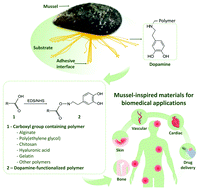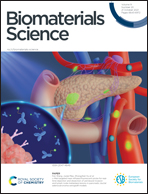Recent developments in mussel-inspired materials for biomedical applications
Abstract
Over the decades, researchers have strived to synthesize and modify nature-inspired biomaterials, with the primary aim to address the challenges of designing functional biomaterials for regenerative medicine and tissue engineering. Among these challenges, biocompatibility and cellular interactions have been extensively investigated. Some of the most desirable characteristics for biomaterials in these applications are the loading of bioactive molecules, strong adhesion to moist areas, improvement of cellular adhesion, and self-healing properties. Mussel-inspired biomaterials have received growing interest mainly due to the changes in mechanical and biological functions of the scaffold due to catechol modification. Here, we summarize the chemical and biological principles and the latest advancements in production, as well as the use of mussel-inspired biomaterials. Our main focus is the polydopamine coating, the conjugation of catechol with other polymers, and the biomedical applications that polydopamine moieties are used for, such as matrices for drug delivery, tissue regeneration, and hemostatic control. We also present a critical conclusion and an inspired view on the prospects for the development and application of mussel-inspired materials.



 Please wait while we load your content...
Please wait while we load your content...